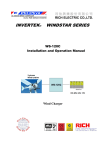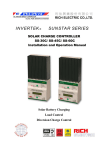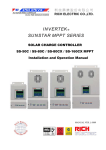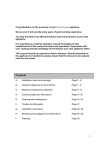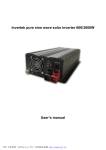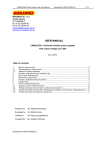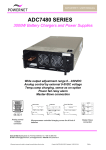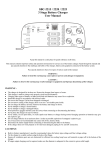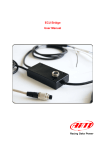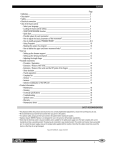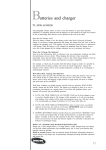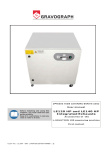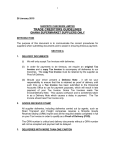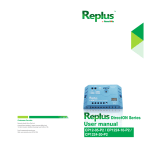Download Battery Charger Manual
Transcript
利佳興業股份有限公司 RICH ELECTRIC CO.,LTD. INVERTEK® SWITCH-MODE BATTERY CHARGER (MICROPROCESSOR SYSTEM) USER MANUAL FOR ALL PATTERNS 1 OUTPUT CONTENTS Introduction............................................................................................................ 2 Technical Features ................................................................................................. 2 Advanced Charging Technique ............................................................................ 3 Safety Devices......................................................................................................... 3 Options.................................................................................................................... 4 Safety Instruction................................................................................................... 4 Installation.............................................................................................................. 5 Front Panel ............................................................................................................. 6 LED Indicators....................................................................................................... 7 Instruction of Charging Curve Selection ........................................................... 7 DC Power Supply................................................................................................... 9 BTS/Remote Control ............................................................................................. 9 Trouble Shooting Guide ...................................................................................... 10 Specification ......................................................................................................... 11 1 Introduction Invertek Battery Charger is small and lightweight charger that offers charging patterns which are perfectly adapted to each battery technology (liquid electrolyte, gel electrolyte, lead calcium, etc... ). A charging pattern may be factory set to suit your specific application. To prolong the life of your batteries and conserve their initial capacity, the charger is programmed with 5 three-state charging patterns: z BOOST Charge/FAST Charge :Restores battery capacity until 80 % in a short space of time. z ABSORPTION Charge/BALANCE Charge : Complements of charge until 100 % of battery capacity z FLOATING Charge/TOP-UP Charge : Compensates for constant battery drain, while keeping the battery fully charged. Invertek Battery Charger is the only charger on the market to allow the battery to be connected and used constantly, while still offering a real BOOST (high voltage) charge over short period. The charger switches back to top-up mode automatically. In accordance with EC standards, the Invertek Battery charger is fitted with a PFC (Power Factor Corrector) which limit peak current draw from the input power required from the generator or Mains supply to be reduced. Technical Features - Management and control by microprocessor Charging curve of 3 states IUU type Input voltage 230V ~ +10%/-15% Frequency 50/60Hz Output voltage Ubat ±1% ; output current Ibat ±5% Operating temperature -10 to + 45°C; storage temperature -20 to +70°C Charging curve selection by rotate switch for 5 different batteries types Sensor used to balance charging voltage according to temperature gaps (-27mV/°C) Automatic air vented cooling Protection Index IP 235 2 Advanced Charging Technique Charging curves of the 3-state IUU type, with a boost phase and a floating phase. The 3-state charging characteristic, used on boats everywhere, saves on charging time. In addition, the charger can be adapted to all types of battery thanks to its 5 integral charging curves supervised by a micro controller. Charge cycle starts on with the mains power-up of product. BOOST/Fast Charge Charging continues at constant current (charger Inom) until the battery reaches the maximum boost voltage. This voltage is maintained until the charging current falls to Inom/8 ~Inom/10 boost charge over short period (12 hours) from the mains power-up of product. This phase makes it possible to supply the maximum amount of energy in the least possible time. FLOATING/Top-Up Charge The charger supplies just the current necessary to keep the battery at a constant and stable voltage (floating voltage). This charging mode allows 12-volt equipment to be used continuously (water pump, refrigeration, auto pilot, radio, lights, etc.) without the batteries discharging. It means that the on-board circuit can be used while keeping the battery charge level constant. WITHOUT BATTERY AND IN SPECIAL CIRCUMSTANCES, THE INVERTEK CHARGER SUPPLIES STABLE VOLTAGE. General form of the charging curve (five possible levels according to battery type) CAPACITY Ah CURRENT VOLTAGE BOOST Fast Charge ABSORPTION Balance Charge FLOATING Top-up Charge Charging Current The nominal current shown in case of nominal voltage is the mean current supplied by the charger. Safety Devices Electronic protection against: - Output short-circuits - Battery discharge in the event of mains failure 3 Disjonction protection against: - Battery overvoltage or undervoltage - Battery or charger overtemperature Protection by fuses against : - Mains input overload - Battery polarity inversion Anti-corrosion Casing in aluminum with anti-corrosion paint. Anti-impact Resistance to impacts in normal use thanks to the 1.8 mm-thick casing (1,5mm for the cover). Ventilation If the internal charger sensor exceeds 45°C, the fan starts. If the internal charger sensor decreases to 40°C, the fan stops. Options 1. Battery Temperature Sensor (BTS): Sensor is used to balance charging voltage according to temperature gaps, compared with reference temperature 25°C. If temperature exceeds 45°C, pre-alarm starts and LED of BTS OH flashes. If temperature exceeds 50°C, charging stops and BTS OH is lit on. Charging restarts when temperature is less than 50°C. Procedure of connecting BTS is: 1. Disconnect the charger from the mains (MANDATORY). To avoid short-circuit, disconnect the batteries. 2. Extract fixing screw from wires cover and remove it 3. Connect the sensor connector to the green terminal on the PCB. (See figure A) 4. Connect charger to the mains 5. Fix the temperature sensor(s) on corresponding battery(ies) with double-sided adhesive tape supplied with sensor. To disconnect sensor from the charger, charger must be disconnected from the mains before (even if the charger indicates a default). CAUTION: In case of fault, charger switches off automatically. Disconnect charger from mains then wait for approximately 10 minutes before starting it again. 2. Remote Control: It can be connected to the Invertek charger. All operating controls and displays are available on the remote control unit. Safety Instruction A battery can generate gas in the case of high overcharge, that can be explosive. Attention must be paid to produce no spark or flame near a battery on charge, arrange for a well-ventilated room. Invertek charger limits overcharges and reduces this risk. z Excessive discharges are among the principal causes of premature wear. Invertek charger prevents such excessive discharge. After every discharge, (especially 4 higher than 50%), recharging should not be deferred for a long time. Low and permanent overcharge is another cause of premature wear. The Invertek Charger delivers the current necessary for battery charge and adapts itself to supply the optimum end of charge. z The accidental and violent overcharge or higher end of charge current produces early destruction by excessive rise of temperature. The temperature should not exceed 50°C. By the regulation of the current, the Invertek protects the battery from the temperature rise at the end of charge. It is advisable to z Put batteries in a well ventilated area z Not to smoke near batteries z Take the battery manufacturer prescriptions into consideration z Accidental Leakage Current between Line And Earth z Connections will be realized by an electrician or a professional installer. z The charger must be connected to a system having a two-pole differential circuit breaker with 30 mA sensitivity. Accidental Leakage Current between Charge Circuit and Earth z To detect accidental leakage currents to earth, you must use a safety device outside the charger. z The rating and nature of the protection must be ensured by the installer. z Special precautions are recommended on any installation where there is a danger of electrolytic effects. z Regulations require the presence of a battery cut-out on the output + pole and on the output – pole. Precautions Regarding Lightning Strike In geographic zones exposed to a high risk of lightning strikes, it may be recommended fitting a lightning conductor on the inlet side of the charger. Rich Electric will not take charge of damaged caused by lightning strike. Precautions Regarding Electromagnetic Interference z Make sure the length of the cables and screening connections are kept as short as possible. z Separate the power supply cables from output cables. z Cables must only carry the charger power supply. Branch or bridging connections in order to supply another equipment are too be banned. Installation The location of the Invertek charger must be chosen by the following criteria: Protection from unauthorized handling. Dry dust free room, no condensation, no rodents. Keep ventilation holes free. The ventilation of the Invertek is designed in such a way that it will work most efficiently when mounted horizontally. Before any connection, put the switch on the right charging curve. 5 1. Connect the positive battery on terminal marker +BAT and open the entry of the upper case to tighten it with screws. 2. Connect the negative battery cable to terminal marker –BAT and open the entry of the upper case to tighten it with screws. Battery fuse board: Model No. 12V/20A 12V/60A FUSE Atofuse (car) 1 x 25A 2 x 30A Model No. 24V/15A 24V/50A FUSE Atofuse (car) 1 x 15A 2 x 30A WARNING: Check carefully the tightness of the battery connections to the charger (risk if not properly tightened). Rich Electric will not take charge of damage caused by a bad tightness of connections. Don’t connect a charge distributor on an Invertek charger, 1 output. 3. Put the AC power cord in the rear panel. The charger operates on sector 90V to 250 VAC - 50/60 Hz. 4. Conductor section according to charge current cables length is as follows. Length Sector flex section (5m) Puissance 5m 10m 15m Current (W) 220V 110V 2 2 2 2 2 30A 6 mm 10 mm 16 mm 1.5 mm 2.5 mm 750 40A 10 mm2 16 mm2 25 mm2 1.5 mm2 1.5 mm2 500 2 2 2 2 2 50A 16 mm 25 mm 35 mm 1.5 mm 2.5 mm 1200 60A 25 mm2 25 mm2 35 mm2 1.5 mm2 2.5 mm2 750 Main fuse board: 12V/20A, 12V/60A, 24V/15A, 24V/50A 16A Model No. Temporized glass fuse 6.3x32mm Front Panel Invertek SWITCH-MODE BATTERY CHARGER MICROPROCESSOR SYSTEM R CAPACITY Ah POWER 1 0 CURRENT BATTERY TYPE BOOST UV/OV OH BOOST VOLTAGE ABSORPTION BTS OH VOLTAGE FLOATING POWER FLOAT VOLTAGE FUSE OPEN BTS BOOTS Fast Charge ABSORPTION Balance Charge FLOATING Top-up Charge 6 Remote Control LED Indicators POWER: It is lit when the AC power has been input through the AC plug. BOOST: It is lit as long as the battery is not fully charged at set charge current. ABSORPTION: It is lit as long as the battery is not fully charged at set voltage. FLOATING: It is lit when the battery is fully charged. UV/OV: Under Voltage---Deep battery discharge Ubat < 10V for 12V system and < 20V for 24V system. If Ubat stays < 10V for 12V system and < 20V for 24 system during more than 5 minutes, charger shuts down. To restart the charger: disconnect the mains, wait few minutes and reconnect the charger on mains. Over Voltage--- Battery overcharge Ubat > 16V for 12V system and > 32V for 24V system. If Ubat > 16V for 12V system and > 32V for 24V system during more than 5 minutes, charger shuts down. To restart the charger: disconnect the mains, wait few minutes and reconnect the charger on mains. OH: Over Heat---It is flashing when the heatsink of the charger reaches > 70℃. The charger shuts down when the charger is > 80℃. BTS OH: Battery Temperature Sensor Over Heat--- It is flashing when the BTS reaches > 45℃. The charger shuts down when the battery temperature is > 50℃. FUSE OPEN: Fuse is broken. Instruction of Charging Curve Selection (4 Battery Types and 1 User Define) Every battery is designed according to particular technology and therefore calls for a particular charging curve. With Invertek battery charger, you can achieve this perfect match between battery and charger using a switch, which is simply positioned according to the required, charging curve. Note: Do indicate the type of your battery when buying the charger, and position the switch correctly before use. The user can very easily adapt the Invertek charger to the type of battery by rotate switch used. To modify configuration, carryout the following steps: STEP 1: Disconnect charger from the mains. To avoid short-circuit, disconnect the batteries. STEP 2: According to 4 different battery types and desired charge current (30%, 70% and 100%), choose the rotate switch from 1 to C. If the used battery is not in 4 listed battery types, User Define is available. 7 Charge Rotate Current Switch 14.4V 13.5V 100% 1 Standard lead acid unsealed 14.4V 13.5V 70% 2 14.4V 13.5V 30% 3 14.2V 13.8V 100% 4 Sealed lead acid (Gel Cell) 14.2V 13.8V 70% 5 14.2V 13.8V 30% 6 14.6V 14.0V 100% 7 Lead calcium 14.6V 14.0V 70% 8 (Standard charge) 14.6V 14.0V 30% 9 16.0V 13.8V 100% A Lead calcium 16.0V 13.8V 70% B (Deep charge) *1 16.0V 13.8V 30% C ─ ─ 100% D User Define *2 ─ ─ 70% E ─ ─ 30% F *1 This curve is used to regenerate the battery electrolyte in case of deep discharge (U Boost 16V), it is indispensable to disconnect the battery from other consumers. BATTERY TYPE U Boost U Float *2 User Define: Use the switches of the BOOST VOLTAGE and FLOAT VOLTAGE to choose desired voltages from the following tables. BOOST VOLTAGE Selection Rotate Boost Rotate Switch Volt. Switch 0 14.4V 5 1 14.5V 6 2 14.6V 7 3 14.7V 8 4 14.8V 9 FLOAT VOLTAGE Selection Rotate Switch Floating Volt. 0 13.5V 1 13.6V 2 13.7V 3 13.8V 4 13.9V Boost Volt. 14.9V 15.0V 15.1V 15.2V 15.3V Rotate Switch A B C D E Rotate Switch 5 6 7 8 9 Boost Volt. 15.4V 15.6V 15.8V 16.0V 14.2V Rotate Switch F Floating Volt. 14.0V 13.1V 13.2V 13.3V 13.4V STEP 3: Connect charger to the mains. Example: To use the Invertek charger of 12V/60A to charge a battery of Sealed lead acid at desired 8 Boost Volt. 14.3V charging current 42A, users should choose rotate switch of battery type to be “5”. DC Power Supply Invertek charger can not only charge the battery but also supply DC power directly. The desired voltage can be set by the following steps. STEP 1: Choose the rotate switch of BATTERY TYPE to be“0”. STEP 2: Use the rotate switch (0~F) of BOOST VOLTAGE to set the first two digits of desired voltage. Refer to the below table for what 0~F represents. Rotate Switch 0 1 2 3 4 Boost Volt. 13.0V 14.0V 15.0V 16.0V 16.0V Rotate Switch 5 6 7 8 9 Boost Volt. 16.0V 16.0V 16.0V 16.0V 16.0V Rotate Switch A B C D E Boost Volt. 16.0V 16.0V 16.0V 16.0V 16.0V Rotate Switch F STEP 3: Use the rotate switch (0~9) of FLOAT VOLTAGE to set the decimal of desired voltage. Refer to the below table for what 0~9 represents. Rotate Switch 0 1 2 3 4 Floating Volt. 0.0V 0.1V 0.2V 0.3V 0.4V Rotate Switch 5 6 7 8 9 Floating Volt. 0.5V 0.6V 0.7V 0.8V 0.9V Example: To set the desired DC power supply of 14.3V, firstly, choose the rotate switch of BATTERY TYPE to be“0”and then choose the rotate switch of BOOST VOLTAGE to be“1”; finally, choose the rotate switch of FLOAT VOLTAGE to be“3”. BTS/Remote Control It is a port for phone jack of the battery temperature sensor and upcoming remote control to be connected. 9 Boost Volt. 16.0V Troubleshooting Guide Problem and Symptoms No output voltage and/or intensity Intensity of charge is too weak and less than 10% Charger delivers a weak output voltage but a max. intensity Possible Cause No alternative current or main fuse is melted down Main or generating unit too weak Battery is almost totally charged Alimentation is too weak Battery consumption > power of the charger One or several elements of the battery present a short-circuit Loss (emission of gas) Battery is quickly empty Sulfate on / stagnation Battery is never totally charged Consumption on the battery during the charge is too important Time of charge is too short Battery temperature too weak Defective battery Defective battery Battery is hot/emission of gas UV/OV LED ON OH LED flashes or ON BTS OH LED flashes or ON Temperature of the battery is too high Stop because of battery voltage < 10 V for 12V or battery voltage > 16V (< 20V/> 32V for a 24V battery ) The charger is near to the "switch off" temperature Solution Check the fuse and replace it Check the input voltage Check that the charger is on a floating mode Check the input voltage Reduce the consumption on the battery Check that there 's no increase of battery temperature Change the battery or check the level of water Charge / discharge several time the battery or check the charging curve or replace the battery Decrease the consumption Choose a more powerful charger Use a temperature sensor Change the battery Replace the battery Use a temperature sensor and/or check the charging curve Disconnect the charger, wait 20 minutes and connect to the main Ventilate the charger Check the charging curve and Battery temperature is too high placed the battery in a (with a temperature sensor) ventilated area 10 Problem and Symptoms Fuse open LED ON Possible Cause Default of the battery which is in deep discharged or polarity inversion of the battery No LED is lighting when the charger is connected to the mains DEFAULT Solution Check the connection of the battery, the polarity and the output fuse Check the main input, the connection of display and the fuses. Specifications Output: 12V Model No. Input Voltage Output Voltage Charging Capacity Frequency Output Patterns Input Voltage U bat Output Current I bat Charging Curve Type Charging Curve Selection Working Temperature Storage Temperature Protection Feature Protection Options Dimensions Weight ADC-20X-122 ADC-60X-122 Input voltage 230V ~ +10%/-15% 12V 20A 60A 50Hz/60Hz 1 or 3 +/-2% +/-10% 3 states IUU type (Boost Charge, Absorption Charge, Floating Charge) By SWITCH for 5 different battery types: Standard lead acid unsealed, Sealed lead acid (Gel Cell), Lead calcium (standard charge/deep discharge), User define -10℃ ~ +45℃ -20℃ ~ +70℃ Against output short-circuit, battery discharge in the event of mains failure, mains input overload, battery polarity inversion Battery or charger overtemperature (Temperature sensor) 310x200x70 mm 400x250x80mm 400x250x80 mm 3 kgs 6 kgs 6 kgs 11 Output: 24V Model No. Input Voltage Output Voltage Charging Capacity Frequency Output Patterns Input Voltage U bat Output Current I bat Charging Curve Type Charging Curve Selection Working Temperature Storage Temperature Protection Feature Protection Options Dimensions Weight ADC-15X-242 ADC-50X-242 Input voltage 230V ~ +10%/-15% 24V 15A 50A 50Hz/60Hz 1 or 3 +/-2% +/-10% 3 states IUU type (Boost Charge, Absorption Charge, Floating Charge) By SWITCH for 5 different battery types: Standard lead acid unsealed, Sealed lead acid (Gel Cell), Lead calcium (standard charge/deep discharge), User define -10℃ ~ +45℃ -20℃ ~ +70℃ Against output short-circuit, battery discharge in the event of mains failure, mains input overload, battery polarity inversion Battery or charger overtemperature (Battery Temperature Sensor) 310x200x70 mm 400x250x80mm 400x250x80 mm 3 kgs 6 kgs 6 kgs ADC – 20 X – 1 2 2 A AC TO DC CHARGER POWER CORD A- American B- UK C- Australia D- Europe 4-STAGE CHARGER HIGH-FREQ. U: DESIGN LOW-FREQ. L: DESIGN X: CHARGE CURRENT 15A 20A 50A 60A OUTPUT VOLTAGE 12VDC 24VDC 12 INPUT VOLTAGE 1- 90~120VAC 2- 180~240VAC 3- 90~240VAC













